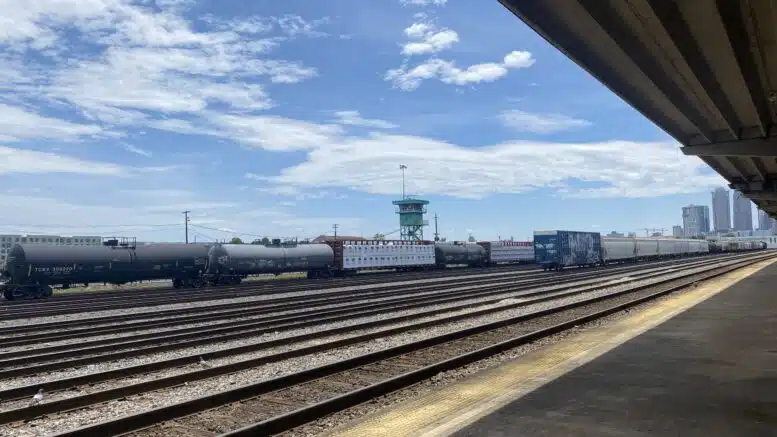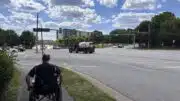By Emily Vespa
When a train barrels toward a pedestrian on the tracks, it’s almost always too late for the engineer to stop.
A strike — so often fatal — can happen in mere seconds, but for a train driver, the collision and the fallout from it can haunt them for a lifetime.
“There’s absolutely nothing you can do about it except sit there and watch the events unfold,” said Wayne Gentry, 79, who faced 43 strikes in his 40-year career driving and working on trains. “You’re totally helpless.”
Gentry, who retired from Norfolk Southern in 2004, said he doesn’t know how many of the people his train struck died. After the first few accidents, he stopped asking about the outcome. It was too painful to process.
But those harrowing events lingered in Gentry’s memory, jolting him awake when he tried to sleep. He’s not alone: In the U.S., most train drivers are involved in at least one fatality in their career.
Railroad tracks are private property, but pedestrians often cut across or near them to save travel time. Rail trespassing is the leading cause of rail-related deaths in the U.S. Forty years of data available from the Federal Railroad Administration show that the number of deaths on the tracks started to slowly climb in 2012. Last year, 718 trespassers were killed by trains in the U.S., the highest peak in at least 40 years.
In North Carolina, 2024 began with a pedestrian death in Thomasville. After his car broke down nearby, 17-year-old Hunter Gardner was on the tracks watching a train headed south when an Amtrak train traveling north struck him from behind. Thomasville police said he likely didn’t hear the train until it was too late.
Researchers and rail safety advocates say the dangers of rail trespassing are overlooked, but its consequences are vast, reaching far beyond the victim on the tracks.
“Just two seconds before a collision”
In North Carolina, which ranks among the top 15 states in the country for rail trespass deaths, researchers at NC State’s Institute for Transportation Research and Education found that dozens of people encroach on portions of the nearly 5,000 miles of railroad tracks across the state daily.
Most of those people are just looking to take the shortest path to a destination, in the same way someone might jaywalk on a road, said Chris Cunningham, associate director of research at the institute. Pedestrians don’t realize that can be a deadly decision.
“A lot of these trains, by the time they’re on top of you, you don’t even know it,” Cunningham said. When a train is 100 feet away from a pedestrian, it’s about as loud as a whistling kettle, he added, which gives a train going 40 mph just two seconds before a collision.
That means many people fatally struck by trains are simply in the wrong place at the wrong time, Cunningham said. Suicide accounts for less than one-third of rail trespass fatalities — though research indicates it’s likely undercounted — and drugs and alcohol are involved in just over half of fatalities.
By placing cameras near railroad tracks in North Carolina where there’s high pedestrian activity, researchers from the Institute for Transportation Research and Education found there were 100 near-miss interactions where pedestrians narrowly avoided an incoming train during the course of a two-year study.
Though some railroad tracks run through or skirt around communities, people don’t learn enough about the risks of wandering on rail tracks, said Margaret Cannell, the state coordinator and executive director for North Carolina’s arm of Operation Lifesaver, a national nonprofit dedicated to preventing injuries and deaths on the railroad.
“You hear when you’re a child, ‘Click it or ticket,’ ‘Booze it and lose it,’” but rail safety isn’t taught in the same way, Cannell said. As a result, rail trespass incidents persist and can impose enormous economic costs on the public, she said, citing research from the research institute’s Steve Bert, program manager of the economic and policy assessment group.
Bert found that in 2019, the cost of casualties, property damage, supply chain delays, operations, first responders, even emissions from stalled trains, from all rail incidents in North Carolina tallied about $258.3 million.
The mental cost
For train drivers, rail trespass casualties take a mental toll.
Cécile Bardon is a professor of psychology at Université du Québec à Montréal, a French-language university in Quebec, Canada. In her research on the psychological effects of rail trespass incidents on rail workers, she said she’s found that after a strike, some suffer long-term symptoms of post-traumatic stress disorder, and many have high stress levels.
Bardon said because trains can’t stop quickly or swerve, when rail workers are involved in a trespass casualty, they can feel helpless. Since a collision is unavoidable, how employers respond after an accident can play a pivotal role in a worker’s recovery, she said.
Bardon found that allowing workers to take three days of leave and asking about their well-being can make a profound, long-term difference in supporting workers’ mental health. She said allowing workers to have discretion over when they return to work can help them regain a sense of control.
In the U.S., a 2014 federal regulation required railroads to establish a plan to support rail workers after a critical incident like a death on the tracks. Amtrak’s plan, which NC Health News obtained under a Freedom of Information Act request, says that after a critical incident, an Amtrak employee must reach out to rail workers who were involved and offer resources and support. Those workers are granted up to three days off of work, no clinical diagnosis necessary.
Gentry, the retired rail engineer who lives in Louisville, Kentucky, said he started volunteering with Operation Lifesaver in the 1980s to help cope with the pain he experienced. Now, he travels across Kentucky to teach people about the dangers of rail trespassing as the state coordinator for the organization, flanked by his emotional support dog, Emmy, a schnauzer-poodle mix.
“I did some therapy, quite a bit as a matter of fact, and eventually came to the conclusion that the only thing that I could do was to do the education and give people awareness and hope they make better choices,” Gentry said.
That, Gentry said, has gone a long way toward helping him heal.











